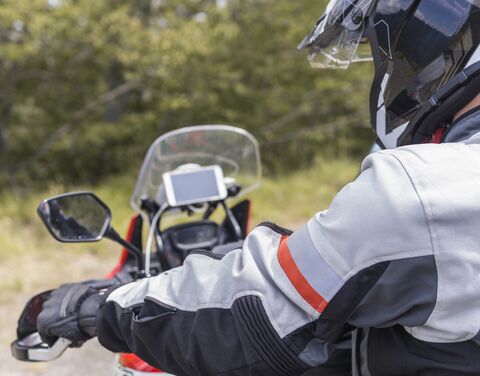
The warmer weather conditions are now also tempting many new motorcyclists to go out for a spin. This is not without its dangers, as most accidents happen at the start of the season. AXA therefore advises even experienced riders to take a motorcycling training course in spring, so that you can ride your motorcycle safely and proactively.
As soon as the weather starts to warm up, motorcycle fans get their bikes out of the shed, garage or basement and mark the season with their first tour. But remember that most accidents happen in spring. "At the beginning of the season in particular, motorcyclists have still not yet got back into the necessary routine – many overestimate their riding skills and are more likely to make mistakes, sometimes with serious consequences," says Luca Genovese, head of Research and Prevention and head of AXA Mobility Competence Center.
Bikers are at significantly greater risk of having a serious accident than car drivers. In the early 1970s, the risk was around 14 times higher; today it's 40 times higher (source: Swiss Council for Accident Prevention (BFU). According to AXA, the most frequent causes of all motorcycle collisions are riders overestimating their own abilities, a lack of motorcycling experience, and excessive risk-taking. The latest accident statistics show that the number of people seriously injured or killed has decreased (source: BFU). Luca Genovese says the important thing now is that this downward trend should not be broken and that bikers learn how to ride their motorcycles well and safely.
"Ideally people should have professional motorcycling training at the start of each season," advises Luca Genovese. It’s not just young or new motorcyclists who benefit from such courses. They also help experienced riders to quickly and safely build on their skills from the previous year. After all, to be fully in control of a motorcycle you also need routine and confidence in your own abilities. To ride a motorcycle safely, you need to retrain these abilities after long seasonal lay-offs.
To make riding your motorcycle is as safe as possible, the machine should be in perfect condition. Before driving over mountain passes on warm days, it's therefore important to check your bike and equipment thoroughly. You must always check:
Ideally start the new season with short trips so that you can practice.
In terms of equipment, there is a great variety of helmets, jackets, shoes and other accessories. The following are essential for riders:
Integral helmet
An integral helmet offers by far the best protection, as it not only protects the top of your head from damage, but also protects your whole face and particularly your chin. When trying it on, make sure that you can place roughly one finger under the chinstrap. Then open the chinstrap and shake your head a little. The helmet shouldn't feel loose when you do this.
Clothing
Ideally your clothing should provide maximum protection and be perfectly comfortable to wear. Leather offers the best protection against abrasion if you fall off, but is very hot in the summer. Textile combinations are more flexible from a seasonal perspective, but they are less robust. Regardless of whether leather or textile combination, it's important to have a back protector as well as protectors for your elbows. A jumpsuit with an integral airbag offers excellent protection against falls. Trousers with knee, hip and shin protectors also protect motorcyclists.
Gloves
Well-fitting gloves help make riding your bike safe. Winter and summer gloves with knuckle, finger and side protection should be part of every rider's basic equipment.
Boots
Feet are particularly vulnerable in motorcycle accidents as well as your hands. To ride your bike as safely as possible, it's a good idea to have boots reinforced with a hard shell. Water-repellent membranes also keep your feet dry.
When it comes to accidents, it's not just up to motorcyclists; other road users also need to get used to motorbikes being back on the road in spring. "About two thirds of collisions between cars and motorcycles are caused by cars; in 54% of cases, the fault lies entirely with the counterpart in the collision. By contrast, only one third of collisions resulting in serious bodily injury are accidents for which a motorcyclist was solely to blame," explains Luca Genovese.
People often fail to notice motorcyclists in traffic or misjudge their speed. So it’s advisable to wear brightly colored clothing, such as a high-visibility yellow vest or belt. Motorcyclists’ crash helmets can also get them noticed more quickly by other road users; white or flashy colored helmets are a particularly good choice for being seen.